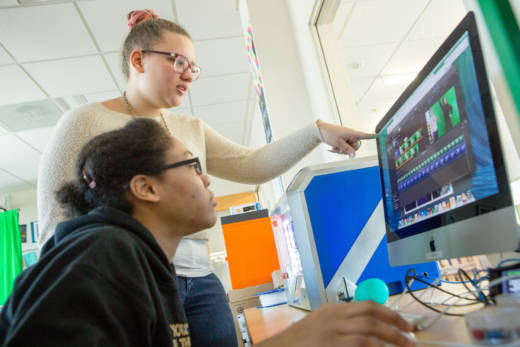School leaders are bringing technology into classrooms more than ever before, often concerned that without access to the tools of the modern work world students will be unprepared when they leave school. But recent studies about the effect of technology on achievement have shown uninspiring results, reinvigorating the conversation about how technology is used in classrooms. Educators who have been active in this space for many years have long known that technology can be used to connect students to the broader world, give them tools to create new and interesting learning artifacts, and open up a world of digital resources. But, technology can also be used to replicate the activities and tests that have always been used in the classroom. The tension between what technology could do and what it is often used for in classrooms is at the heart of a debate over whether all the money pumped into technology is worth it.
Kristina Rizga dives into this debate in an article for Mother Jones that looks at Summit Public Schools, a charter network with major Silicon Valley backing. Summit is seen by many in education as carefully walking a middle road between two theories of education reform Stanford education professor emeritus Larry Cuban calls "efficiency-driven reform" and "student-centered reform" based on personalized learning, a term that has become increasingly vague. But not every school interested in "personalizing learning" with technology has the resources and vision of Summit Public Schools. Rizga writes:
Nationally, a 2017 study from the RAND Corporation funded by the Bill and Melinda Gates Foundation looked at 40 schools implementing tech-infused personalized-learning programs—all also funded by Gates—for at least one year. While researchers found that personalized learning did lead to modest gains in test scores, none of the schools trying out the approach looked that different from traditional ones: Teachers tailored lessons to individual students to a similar degree, and students had roughly the same amount of choices in the classrooms compared with traditional schools. On top of that, educators complained they didn’t have enough time to plan individualized lessons, and that the constraints of standardized outcomes to measure success made personalization difficult. Researchers concluded that the latest trend in education “may not work everywhere, and it requires careful thought about the context that enables it to work well.”
The Summit Public Schools approach is still relatively new in the education world, and fairly untested. Some educators and parents see that as a reason to slow tech-driven experiments until they have been better studied and tested. Others see a changing economy that is quickly leaving many behind and believe it's time for dramatic changes, with no time to wait. Many technology-driven initiatives in schools are not doing very much to change what and how kids learn, but some are. And how will teachers know how to integrate technology well, without a little trial and error? The Summit Public Schools model has changed over the past decade as the educators working there recognize their students need different things. How can educators across the country embody this type of iteration without being slammed for "experimenting on kids"?
http://www.motherjones.com/politics/2017/11/inside-silicon-valleys-big-money-push-to-remake-american-education/


